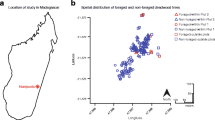Abstract
Aye-ayes (Daubentonia madagascariensis) use the thin middle finger to tap on wood in search of subsurface cavities containing insect larvae. When a cavity is located, they gnaw away wood until the prey can be extracted. Previous researchers suggested that acoustical cues reveal cavity location. We designed five studies to identify the cavity features that provide acoustical cues. When cavities were backfilled with gelatin or acoustical foam, excavation was still successful, suggesting that the reverberation of sound in air-filled cavities is not necessary for detection. Moreover, when the density of cavity content was varied, there was no difference in excavation frequency. On the other hand, a one-dimensional break in the subsurface wood was an effective stimulus for excavation. These studies suggest that a simple interface beneath the surface is sufficient to elicit excavation and that neither prey nor cavity nor even small air pockets are necessary to elicit the behavior. These results raise provocative questions as to how the aye-aye manages to forage efficiently.
Similar content being viewed by others
REFERENCES
Erickson, C. J. (1991). Percussive foraging in the aye-aye, Daubentonia madagascariensis. Anim. Behav. 41: 793-801.
Erickson, C. J. (1994). Tap-scanning and extractive foraging in aye-ayes, Daubentonia madagascariensis. Folia Primatol. 62: 125-135.
Erickson, C. J. (1998). Cues for prey location by aye-ayes (Daubentonia madagascariensis). Folia Primatol. (in press).
Ganzhorn, J. U., and Rabesoa, J. (1986). The aye-aye (Daubentonia madagascariensis) found in the eastern rainforest of Madagascar. Folia Primatol. 46: 125-126.
Milliken, G. W., Ward, J. P., and Erickson, C. J. (1991). Independent digit control in the aye-aye (Daubentonia madagascariensis). Folia Primatol. 56: 219-224.
Owen, R. (1866). On the aye-aye (Chiromys cuvier). Trans. Zool. Soc. Lond. 5: 33-101.
Petter, J. J. (1977). The aye-aye. In H. S. H. Prince Rainier III and Bourne, G. H. (eds.), Primate Conservation, Academic Press, New York, pp. 37-57.
Siegel, S., and Castellan, N. J. (1988). Nonparametric Statistics for the Behavioral Sciences, 2nd ed., McGraw-Hill, New York.
Sterling, E. J. (1993). Behavioral Ecology of the Aye-Aye (Daubentonia madagascariensis) on Nosy Mangabe, Madagascar, Ph.D. thesis, Yale University, New Haven, CT.
Sterling, E. J., Dierenfeld, E. S., Ashbourne, C. J., and Feistner, A. T. C. (1994). Dietary intake, food composition and nutrient intake in wild and captive populations of Daubentonia madagascariensis. Folia Primatol. 62: 115-124.
Author information
Authors and Affiliations
Rights and permissions
About this article
Cite this article
Erickson, C.J., Nowicki, S., Dollar, L. et al. Percussive Foraging: Stimuli for Prey Location by Aye-Ayes (Daubentonia madagascariensis). International Journal of Primatology 19, 111–122 (1998). https://doi.org/10.1023/A:1020363128240
Issue Date:
DOI: https://doi.org/10.1023/A:1020363128240




